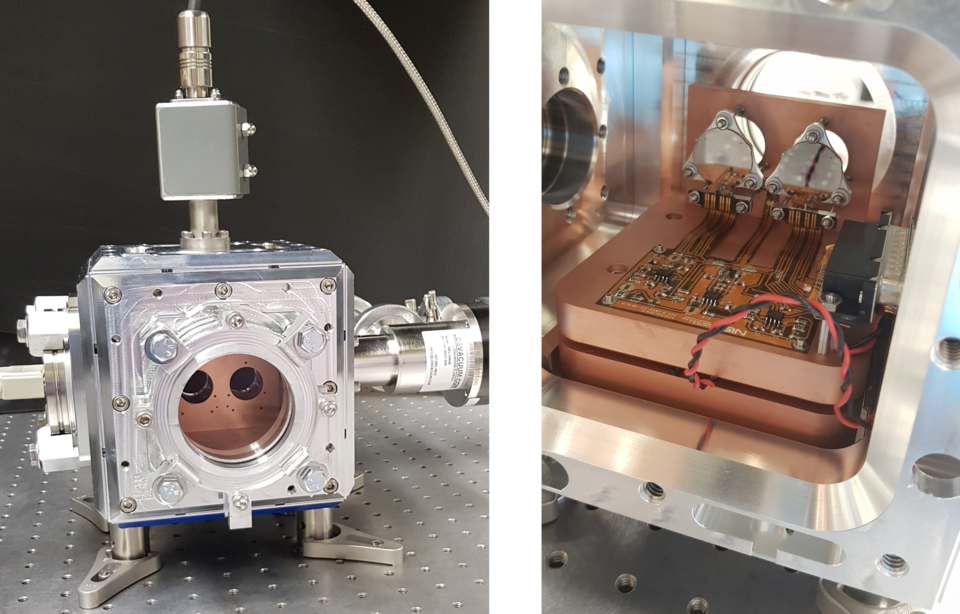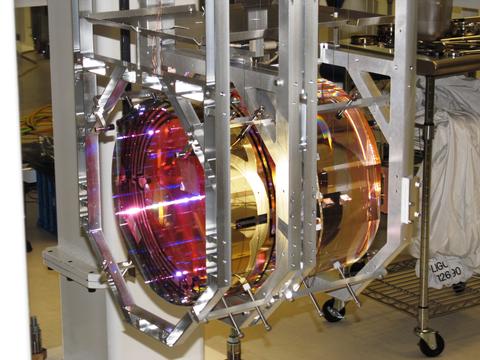Calibrating the Universe: Behind the Scenes, NIST Scientists Play a Critical Role in Improving Gravitational Wave Measurements
Space-time ripples, exploding stars, colliding black holes …. and the National Institute of Standards and Technology? NIST doesn’t exactly come to mind when thinking about cataclysmic events in the cosmos. But behind the scenes, NIST played an essential supporting role in the Nobel Prize-winning discovery of ripples in spacetime — gravitational waves — which scientists at the Laser Interferometer Gravitational-Wave Observatory (LIGO) announced in 2015. NIST researchers helped calibrate the gravitational-wave detector system, ensuring that the LIGO team accurately measured the historic event.
Now, the NIST scientists have more than doubled the accuracy of those calibrations. When LIGO resumes observations in mid-December, the new calibrations will enable astronomers to more accurately pinpoint the origin and nature of future space-time disturbances.

The first ripple ever directly detected arrived at LIGO’s twin sites in Louisiana and Washington state on Sept. 14, 2015. Generated by the collision of two black holes, the wave had journeyed 1.3 billion light-years to reach Earth. The detection provided stunning confirmation of Albert Einstein’s century-old prediction that massive bodies undergoing acceleration not only distort but actually shake space-time.
The discovery was also a technological feat. Each LIGO observatory features two L-shaped, 4-kilometer-long arms that form an exquisitely sensitive interferometer, a device that uses light to measure distance. When a gravitational wave passes by, it alternately compresses one arm while stretching the other by an amount much less than the diameter of a single proton. This alters the relative separation between sets of mirrored test masses, suspended within each arm.
The size of the displacement induced by the wave and the frequency at which the wave oscillates encode information that cosmologists have sought for decades about some of the most violent events in the universe. The data include the location in the sky, the exact distance from Earth, and the mass and identity of the cosmic participants in these massive collisions. To accurately determine these properties, LIGO researchers must measure the displacement imparted by a gravitational wave to better than one ten-thousandth the diameter of a proton. Even then, scientists can’t reliably determine the force and other features of the gravitational wave unless they can compare the tiny displacement it imparts to the same displacement imparted by a well-calibrated force.

The power carried by a ray of light can be equated to the force it imparts to objects it strikes. The force is tiny, but if the power is accurately measured, that tiny force can be, too. LIGO scientists use a low-power infrared laser to produce the force. The laser light bouncing off the mirrored mass nudges the body ever so slightly, simulating the action of a gravitational wave. To ensure accuracy, that power must be precisely calibrated. And that’s where the expertise of scientists at NIST comes in.
Meeting the needs of U.S. industry, defense and academic research, NIST calibrates laser power ranging from the output of single photons (less than a billionth of a watt) to more than 10,000 watts, and across wavelengths from the ultraviolet to far infrared. To perform these calibrations, NIST researchers over the past four decades have developed and employed two types of devices — calorimeters, which measure the total energy generated by a system, and radiometers, which measure the intensity of radiation. These instruments, now operated by a NIST team led by Matthew Spidell, measure optical power and energy without having to compare those quantities to those measured by another instrument. Instead, the instruments enable researchers to directly link optical power and energy to the fundamental physical constants, which by definition do not vary and require no calibration.
Although a modern-day calorimeter includes a complex system of hardware and software, its operation is relatively simple. The calorimeter itself is an insulated vessel coated internally with carbon black, which absorbs light readily.
Attached to this vessel is a thermometer and an electrical heating element. Using the heating element to apply a known amount of electrical power to the vessel, the NIST researchers measure the increase in its temperature. After switching off the electrical source and allowing the vessel to cool, the researchers shine an uncalibrated source of laser light onto the calorimeter until it reaches the same temperature increase. The scientists can then directly equate the unknown amount of laser power required to reach that temperature with the known amount of electrical energy. With the laser power now known, the NIST team calibrates other optical devices.
Using calorimetry, the NIST researchers measured laser power with high precision — within 0.6% of its actual value. That worked well for LIGO’s first two observing runs, which ended in 2017. Now the LIGO researchers want to reduce that uncertainty even further before they resume operations this December.
To meet that goal, the NIST team began using another, more recently developed calibration system last November, developed by NIST international associate Anna Vaskuri, now a physicist at CERN. The system uses a radiometer to measure the intensity of incoming radiation.
First, the researchers apply a known amount of electrical heat to a light-absorbing material — carbon nanotubes, the blackest material known — so that the material equilibrates with its surroundings, reaching a constant temperature. Then the scientists irradiate the nanotubes with laser light from an uncalibrated source, which injects additional heat into the system. Immediately, however, the electrical heating is reduced so that the light-absorbing carbon nanotubes remain at the same temperature instead of rising. The measured decrease in electrical heating required to maintain a constant temperature quantifies the amount of optical power that was added.
The radiometer reduces the uncertainty in laser power to 0.16%, Spidell said. The method offers another advantage — a shorter cool-down time between successive measurements than the conventional calorimetric method requires. That enables the NIST researchers to complete a series of measurements in about half the time.
NIST isn’t the only national metrology institute that LIGO relies on for its laser calibrations. The Physikalisch-Technische Bundesanstalt (PTB) in Braunschweig, Germany, also participates. This year, NIST and PTB plan to compare their results in time for the next LIGO observing run.
Future calibrations of the LIGO optical power should further reduce uncertainty in the measurements, said Spidell. That will enable LIGO scientists to more accurately extract critical information, such as the mass and distance of the objects generating the gravitational waves, and help cosmologists better understand exotic events throughout the cosmos.
Paper: Anna K. Vaskuri, Michelle S. Stephens, Nathan A. Tomlin, Matthew T. Spidell, Christopher S. Yung, Andrew J. Walowitz, Cameron Straatsma, David Harber and John H. Lehman. High-accuracy room temperature planar absolute radiometer based on vertically aligned carbon nanotubes. Optics Express. Published July 1, 2021. DOI: 10.1364/OE.427597

